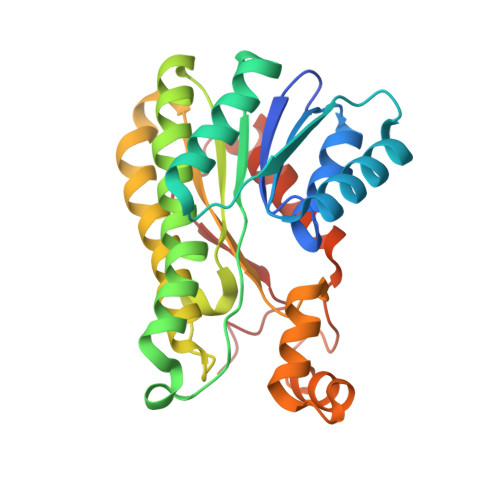The Crystal Structure and Stereospecificity of Levodione Reductase from Corynebacterium aquaticum M-13
Sogabe, S., Yoshizumi, A., Fukami, T., Shiratori, Y., Shimizu, S., Takagi, H., Nakamori, S., Wada, M.(2003) J Biological Chem 278: 19387-19395
- PubMed: 12621044
- DOI: https://doi.org/10.1074/jbc.M208146200
- Primary Citation of Related Structures:
1IY8 - PubMed Abstract:
The (6R)-2,2,6-trimethyl-1,4-cyclohexanedione (levodione) reductase (LVR) of the soil isolate bacterium Corynebacterium aquaticum M-13 is a NAD(H)-linked enzyme that catalyzes reversible oxidoreduction between (4R)-hydroxy-(6R)-2,2,6-trimethylcyclohexanone (actinol) and levodione. Here the crystal structure of a ternary complex of LVR with NADH and its inhibitor 2-methyl-2,4-pentanediol has been determined by molecular replacement and refined at 1.6-A resolution with a crystallographic R factor of 0.199. The overall structure is similar to those of other short-chain alcohol dehydrogenase/reductase enzymes. The positions of NADH and 2-methyl-2,4-pentanediol indicate the binding site of the substrate and identify residues that are likely to be important in the catalytic reaction. Modeling of the substrate binding in the active site suggests that the specificity of LVR is determined by electrostatic interactions between the negatively charged surface of Glu-103 of LVR and the positively charged surface on the re side of levodione. Mutant LVR enzymes in which Glu-103 is substituted with alanine (E103A), glutamine (E103Q), asparagines (E103N), or aspartic acid (E103D) show a 2-6-fold increase in Km values as compared with wild-type LVR and a much lower enantiomeric excess of the reaction products (60%) than the wild-type enzyme (95%). Together, these data indicate that Glu-103 has an important role in determining the stereospecificity of LVR.
- Nippon Roche Research Center, 200 Kajiwara, Kamakura, Kanagawa 247-8530, Japan.
Organizational Affiliation:


















